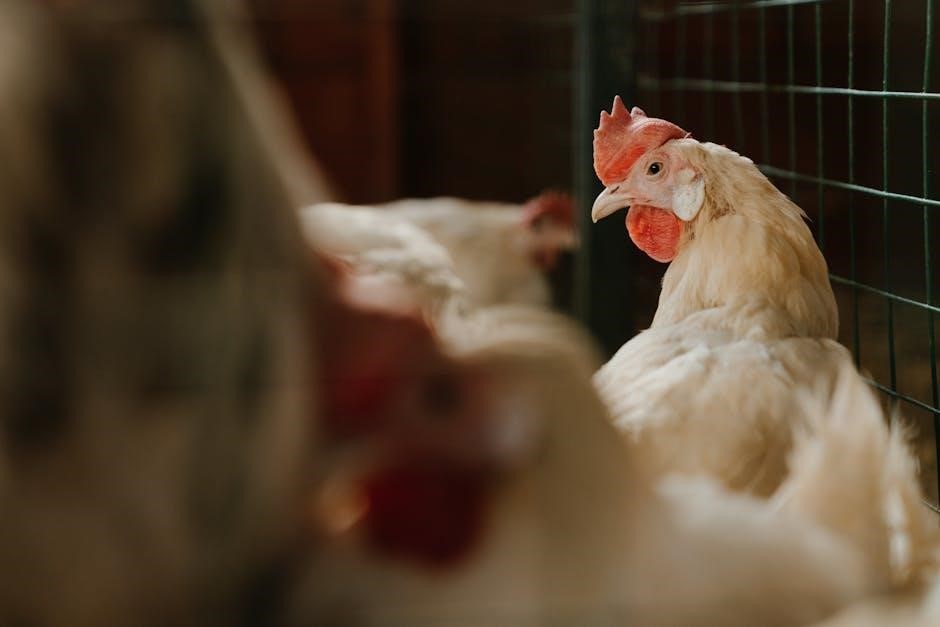Maya Angelou’s I Know Why the Caged Bird Sings is a powerful autobiography exploring her early years, racial struggles, and personal resilience in mid-20th century America.
Overview of “I Know Why the Caged Bird Sings”
I Know Why the Caged Bird Sings is Maya Angelou’s deeply personal autobiography, recounting her childhood and adolescence in the segregated South. The book explores themes of racism, identity, and resilience, capturing her journey from trauma to self-discovery. Angelou’s vivid storytelling and poetic prose illuminate her experiences, creating a powerful narrative that reflects her growth and the societal challenges she faced.
Significance of the Book
I Know Why the Caged Bird Sings holds profound cultural and literary significance as a candid depiction of racial inequality and personal resilience. It provides a crucial account of life as a Black woman in mid-20th century America, offering insights into systemic racism’s impact. The book’s raw honesty and emotional depth have made it a landmark in African American literature, resonating with readers globally and inspiring future writers and social change.
Author Background
Maya Angelou, a celebrated American writer and poet, authored the groundbreaking autobiography I Know Why the Caged Bird Sings, reflecting her life experiences with racism and resilience.
Maya Angelou’s Life and Career
Maya Angelou, a renowned American writer and poet, led a life marked by resilience and creativity. Born in 1928, she experienced racism and personal trauma, including sexual assault, which she courageously depicted in her writings. Angelou’s career spanned multiple fields, including theater, music, and civil rights activism. Her autobiography, I Know Why the Caged Bird Sings, became a landmark work, cementing her legacy as a powerful voice in African American literature and culture.
Why She Wrote the Book
Maya Angelou wrote I Know Why the Caged Bird Sings to confront her traumatic childhood, challenge racial stereotypes, and empower others through her story. The book, part of a seven-volume autobiography series, reflects her journey toward self-discovery and resilience. By sharing her experiences, Angelou aimed to shed light on the struggles faced by African Americans and to inspire hope and unity in the face of adversity and injustice.
Historical Context
I Know Why the Caged Bird Sings is set in mid-20th century America, reflecting the era’s racism, segregation, and societal norms that shaped Maya’s childhood experiences.
Racism and Segregation in Mid-20th Century America
The book vividly portrays the profound impact of systemic racism and segregation on Black communities, highlighting the daily struggles faced by African Americans during this oppressive era.
The Impact of Setting on the Story
The rural South and urban North settings in I Know Why the Caged Bird Sings shape Maya’s experiences with racism, identity, and resilience. Stamps, Arkansas, represents segregation and oppression, while St. Louis symbolizes fleeting freedom. The contrast between these environments highlights the pervasive nature of racial inequality and its profound effect on Maya’s growth and understanding of the world.
Major Themes
Central themes in I Know Why the Caged Bird Sings include racism, identity, resilience, and personal growth, reflecting Maya’s journey through adversity and self-discovery.
Racism and Identity
In I Know Why the Caged Bird Sings, racism profoundly shapes Maya’s identity. Growing up in a segregated society, she grapples with internalized racism and self-worth, gradually embracing her Black heritage. The book vividly portrays how systemic racism impacts her childhood, influencing her sense of self and resilience. Through her experiences, Angelou highlights the struggle for racial equality and personal identity in a prejudiced world.
Resilience and Personal Growth
Maya’s journey in I Know Why the Caged Bird Sings exemplifies resilience and personal growth. Despite facing racism, trauma, and adversity, she evolves from a vulnerable child to a confident young woman. Through literature and supportive figures, Maya discovers her voice and strength, illustrating how resilience fosters personal transformation and self-discovery in the face of overwhelming challenges.

Symbols and Motifs
The caged bird symbolizes oppression and longing for freedom, while singing represents defiance against injustice. Nature and confinement motifs highlight the struggle between freedom and societal constraints.
The Caged Bird as a Symbol
The caged bird, inspired by Paul Laurence Dunbar’s poem “Sympathy,” symbolizes the oppressive experiences of African Americans and their longing for freedom. It reflects Maya’s personal struggles with racism and identity, embodying the tension between confinement and the desire to soar; The bird’s song, though muted, signifies resilience and hope, mirroring Maya’s own journey toward self-discovery and liberation amidst societal constraints. This powerful metaphor underscores themes of oppression and the enduring human spirit.
Other Recurring Symbols
Beyond the caged bird, Angelou uses the symbol of singing to represent defiance and resistance against injustice. The Black National Anthem and grandmother Baxter’s soft singing during harassment exemplify this. Additionally, the motif of nature, such as cotton fields and the Mississippi River, serves as a backdrop for the struggles and resilience of Black life in the South, symbolizing both hardship and the enduring spirit of the community.
Narrative Style
The autobiography is told from Maya’s first-person perspective, blending childlike authenticity with reflective gravity, offering a poignant balance of innocence and mature retrospection.
First-Person Point of View
The autobiography is narrated through Maya’s first-person perspective, creating an intimate and immediate connection with her experiences. This narrative choice allows readers to witness her growth from a naive child to a self-aware adolescent, blending raw emotions with reflective insights. The first-person voice captures the authenticity of her journey, offering a personal lens through which themes of identity, racism, and resilience are explored.
Reflective Tone and Balancing Perspectives
Angelou employs a reflective tone, blending childhood naivety with adult hindsight, which enriches the narrative depth. This duality allows her to present both the immediacy of her youthful experiences and the broader understanding gained over time. By balancing these perspectives, she crafts a story that is both deeply personal and universally relatable, offering insights into her emotional and intellectual growth.
Reception and Impact
I Know Why the Caged Bird Sings gained critical acclaim for its raw honesty and cultural significance, becoming a landmark in African American literature, despite facing bans and controversies.
Popularity and Critical Acclaim
I Know Why the Caged Bird Sings became a bestseller and a landmark in African American literature, praised for its vivid storytelling and unflinching portrayal of racism and personal trauma. Its raw honesty resonated with readers, making it widely taught in schools and admired for its literary depth, despite addressing sensitive topics like sexual assault and segregation.
Controversies and Bans
Despite its acclaim, I Know Why the Caged Bird Sings has faced censorship due to its frank depiction of rape, racism, and explicit language. Many schools and libraries have banned it, citing inappropriate content for young readers. These controversies highlight the book’s challenging themes, sparking debates about freedom of expression and educational value in literature.
Legacy and Influence
I Know Why the Caged Bird Sings has become a seminal work in African American literature, inspiring countless writers and cementing Angelou’s legacy as a trailblazing voice.
Effect on African American Literature
I Know Why the Caged Bird Sings revolutionized African American literature by offering a candid, personal narrative of race, gender, and resilience. It paved the way for Black women writers, breaking barriers and challenging stereotypes. Angelou’s unflinching honesty about trauma and identity resonated deeply, giving voice to marginalized experiences. The book’s success marked a turning point, establishing autobiographical storytelling as a powerful tool for social commentary and empowerment within African American literary tradition.
Influence on Subsequent Writers
Maya Angelou’s memoir inspired countless writers by demonstrating the power of personal narrative. It influenced authors like Alice Walker, Toni Morrison, and bell hooks, who followed her lead in addressing race, gender, and identity. The book’s authenticity and lyrical prose set a new standard for autobiographical writing, encouraging others to share their stories. Its impact continues to resonate, shaping modern literature and empowering voices across generations.

Literary Devices
Angelou employs vivid imagery, metaphors, and personification to convey emotional depth and themes. The caged bird symbolizes oppression, while its song represents resilience and hope, enriching the narrative.
Metaphors and Similes
Angelou uses metaphors and similes to vividly depict her experiences. The caged bird symbolizes oppression, while the freed bird represents liberation and hope. She compares her voice to a “freed bird” and her growth to blossoming flowers, emphasizing resilience and transformation. These literary devices enrich the narrative, offering profound insights into her journey of self-discovery and defiance against societal constraints.
Personification and Its Role
Angelou masterfully employs personification to convey emotional depth and societal critique. The caged bird’s song symbolizes defiance and longing, while nature often mirrors human emotions. For instance, the wind and trees are personified to reflect the heaviness of racial tension. This technique allows Angelou to illustrate the internal and external struggles of her character, making the narrative more relatable and impactful.

Structure and Setting
The autobiography is set in mid-20th century America, primarily in Stamps, Arkansas, and St. Louis. The chronological structure follows Maya’s journey from childhood to adolescence, reflecting racial tensions and personal growth through vivid depictions of her environments.
Chronological Structure
The autobiography follows a clear chronological order, tracing Maya’s life from age 3 to 16. The narrative flows through her experiences in Stamps, Arkansas, and St. Louis, highlighting key events that shaped her identity. This structure allows readers to witness her growth firsthand, offering a vivid reflection of her journey through childhood and adolescence amid racial tensions and personal struggles.
Significant Settings
The primary settings in I Know Why the Caged Bird Sings are Stamps, Arkansas, and St. Louis, Missouri. Stamps, with its rural segregation and strong community ties, shapes Maya’s early identity and exposes her to racism. St. Louis, in contrast, introduces urban life and broader societal challenges, playing a pivotal role in her formative experiences and personal growth during her adolescence.

Key Characters
Maya and her brother Bailey are central figures, navigating racial challenges and personal growth. Influential figures like their grandmother and mentors shape Maya’s journey and identity formation.
Maya and Her Brother Bailey
Maya and her brother Bailey share a profound bond, navigating childhood challenges together. Their relocation to Stamps, Arkansas, exposes them to racism and societal inequities. Bailey, protective and supportive, helps Maya cope with her struggles, including her traumatic experiences. Their relationship underscores themes of sibling loyalty and resilience, shaping Maya’s early years and personal growth in the face of adversity.
Influential Figures in Her Life
Maya’s life is shaped by pivotal figures, including her grandmother, “Momma” Henderson, who instills resilience and moral strength. Mrs. Bertha Flowers, a teacher, introduces her to literature, fostering a love for words. Her father, Bailey Johnson Sr., though absent, leaves an indelible mark on her identity. These figures guide Maya through her formative years, influencing her perspective and growth amidst racial and personal challenges.
I Know Why the Caged Bird Sings remains a timeless exploration of identity, resilience, and the struggle for justice, leaving an indelible mark on literature and society.
Enduring Relevance
I Know Why the Caged Bird Sings remains widely read and taught, offering timeless insights into racism, sexism, and personal growth. Its raw portrayal of resilience resonates with new generations, sparking essential conversations about identity and justice. The book’s authenticity and Maya’s reflective voice ensure its relevance, making it a cornerstone of American literature and a powerful tool for understanding the Black experience in 20th-century America.
Final Thoughts on the Book’s Significance
I Know Why the Caged Bird Sings stands as a landmark autobiography, offering profound insights into racial inequality, personal resilience, and the transformative power of literature. Its raw honesty and lyrical prose have inspired countless readers, making it a cornerstone of American literature. The book’s exploration of identity, trauma, and hope continues to resonate, cementing its legacy as a vital work in understanding the African American experience and fostering empathy across generations.
